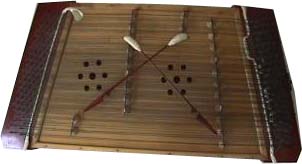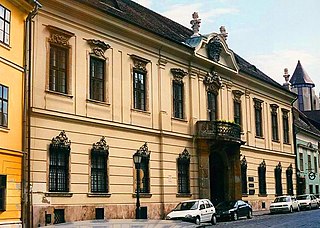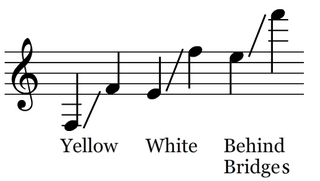
The term dulcimer refers to two families of musical string instruments.

The hammered dulcimer is a percussion-stringed instrument which consists of strings typically stretched over a trapezoidal resonant sound board. The hammered dulcimer is set before the musician, who in more traditional styles may sit cross-legged on the floor, or in a more modern style may stand or sit at a wooden support with legs. The player holds a small spoon-shaped mallet hammer in each hand to strike the strings. The Graeco-Roman word dulcimer derives from the Latin dulcis (sweet) and the Greek melos (song). The dulcimer, in which the strings are beaten with small hammers, originated from the psaltery, in which the strings are plucked.

Klezmer is an instrumental musical tradition of the Ashkenazi Jews of Central and Eastern Europe. The essential elements of the tradition include dance tunes, ritual melodies, and virtuosic improvisations played for listening; these would have been played at weddings and other social functions. The musical genre incorporated elements of many other musical genres including Ottoman music, Baroque music, German and Slavic folk dances, and religious Jewish music. As the music arrived in the United States, it lost some of its traditional ritual elements and adopted elements of American big band and popular music. Among the European-born klezmers who popularized the genre in the United States in the 1910s and 1920s were Dave Tarras and Naftule Brandwein; they were followed by American-born musicians such as Max Epstein, Sid Beckerman and Ray Musiker.

Zither is a class of stringed instruments. The modern instrument has many strings stretched across a thin, flat body.
Hungary has made many contributions to the fields of folk, popular and classical music. Hungarian folk music is a prominent part of the national identity and continues to play a major part in Hungarian music. The Busójárás carnival in Mohács is a major folk music event in Hungary, formerly featuring the long-established and well-regarded Bogyiszló orchestra. Instruments traditionally used in Hungarian folk music include the citera, cimbalom, cobza, doromb, duda, kanászkürt, tárogató, tambura, tekero and ütőgardon. Traditional Hungarian music has been found to bear resemblances to the musical traditions of neighbouring Balkan countries and Central Asia.

The gusli is the oldest East Slavic multi-string plucked instrument, belonging to the zither family, due to its strings being parallel to its resonance board. Its roots lie in Veliky Novgorod in Novgorodian Republic. It has its relatives in Europe and throughout the world: kantele in Finland, kannel in Estonia, kanklės in Lithuania, kokles in Latvia, Zither in Germany, citera in the Czech Republic, and psalterium in France. Furthermore, the kanun has been found in Arabic countries, and the autoharp, in the United States. It is also related to such ancient instruments as Chinese gu zheng, which has a thousand-year history, and its Japanese relative koto. A stringed musical instrument called guslim is listed as one of the Me in ancient Sumer.

The tsymbaly is the Ukrainian version of the hammer dulcimer. It is a chordophone made up of a trapezoidal box with metal strings strung across it. The tsymbaly is played by striking two beaters against the strings.

Gábor Darvas was a Hungarian composer and musicologist. He was one of the first Hungarian composers to work in the field of electronic music. As a musicologist, his interest was primarily in music of the 15th and 16th centuries.

József Schunda (1818–1893) and Vencel József Schunda were uncle and nephew and Czech-born Hungarian musical instrument makers.

Budapest has long been an important part of the music of Hungary. Its music history has included the composers Franz Liszt, Ernő Dohnányi, Zoltán Kodály and Béla Bartók and the opera composer Ferenc Erkel.

Eugene Zador was a Hungarian and American composer.

Moravian traditional music or Moravian folk music represents a part of the European musical culture connected with the Moravian region of the Czech Republic. Styles of Moravian traditional music vary by location and subject, but much of it is characterized by a specific melodic and harmonic texture related to the Eastern European musical world. According to Czech musicologist Jiří Plocek, Moravia is the area where the European East musically meets the West.
Budapest Gypsy Symphony Orchestra is a Hungarian symphony orchestra of Romani (Gypsy) musicians. It emphasizes works by composers inspired by Hungarian folk and urban music including Franz Liszt, Johannes Brahms, Vittorio Monti, Piotr Tchaïkovski, Johann Strauss and Johann Strauss II. The orchestra has been performing for 30 years as a classical symphony orchestra.
The term Romani style refers to the way Eastern European music is played in coffeehouses and restaurants, at parties, and sometimes on-stage in European cities. Music played in this style differs from actual Romani music played by Romani and Sinti people, many of whom regard the term "gypsy" as a slur when applied to their community.
Damping is a technique in music for altering the sound of a musical instrument by reducing oscillations or vibrations. Damping methods are used for a number of instruments.

Kálmán Balogh is a Hungarian cimbalom player and leader of Kálmán Balogh's Gypsy Cimbalom Band.

The Bashalde are a Romani subgroup in the United States of America. The subgroup is linked to a migration of Romani people to the United States in the late 19th century, from the historical Kingdom of Hungary. Many migrated from what is now Košice, Slovakia. They settled in the cities of Braddock, Homestead, Johnstown, and Uniontown, Pennsylvania; Cleveland and Youngstown, Ohio; Detroit and Delray, Michigan; Gary, Indiana; Chicago, and New York City and Las Vegas. The Balshade were a community of settled Romani, and in the United States were well known for playing music for the Central European immigrant communities in which they settled. These Romani were known for playing in cafes and restaurants, the name Bashalde emerged in the late 20th century; portions of them were also known as Romungre. In the early 1900s the Romani in Braddock, Pennsylvania, purchased an entire block of homes, making them the largest population of settled Romani in the United States.

The santur, is a hammered dulcimer of Iranian origins.

Aladár Rácz was a Hungarian cimbalom player known for adapting Baroque harpsichord and clavecin repertoire for the cimbalom, which is traditionally a Hungarian folk music instrument. He was the winner of the 1948 Kossuth Prize and influenced the composer Igor Stravinsky to incorporate the cimbalom into his compositions.
Metro Radomsky was a well-known Ukrainian Canadian fiddle player of the twentieth century. His band was one of the earliest bands to record Ukrainian music in the Canadian Prairies in the 1930s; his orchestra continued playing until 1989.




















